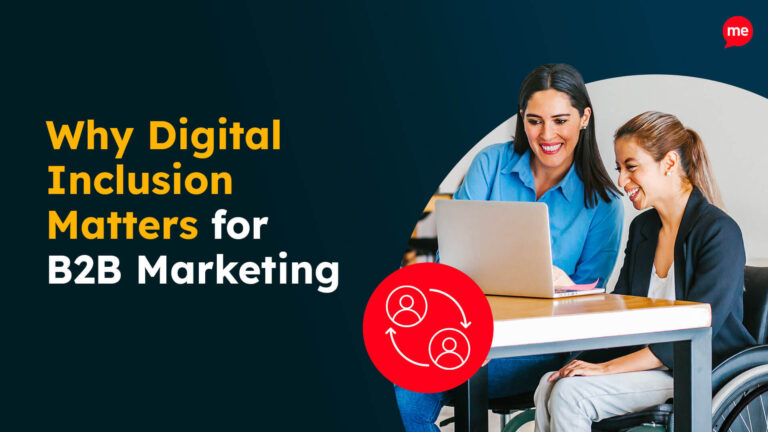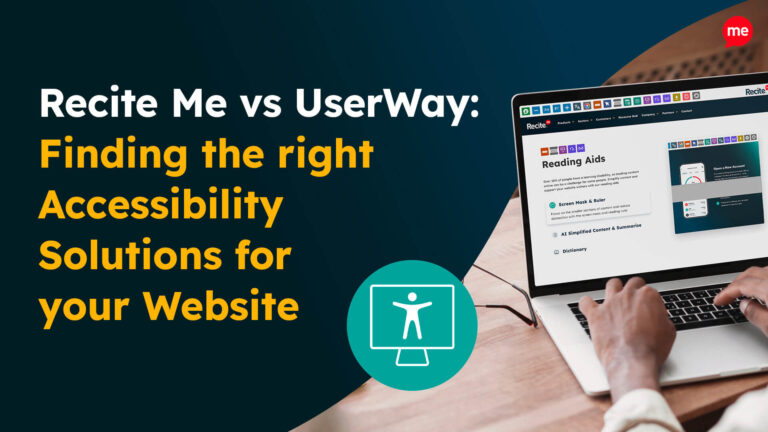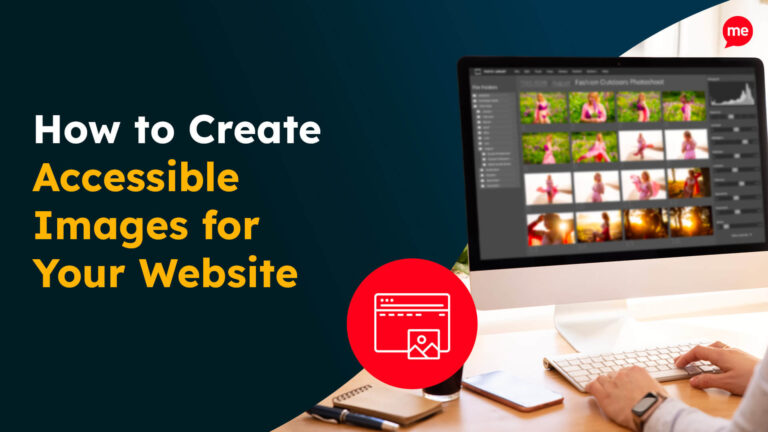Get Your Free Accessibility & Inclusion Toolkit
Download NowWorkplace accessibility ensures that your working environment is accessible to all people, including those with physical, mental and cognitive disabilities. This means that individuals with disabilities are able to enjoy working at your company without dealing with discriminatory barriers. Accessibility in the workplace includes the physical workplace, but also organisational culture and digital accessibility.
Disability accessibility is essential for equality and inclusivity. So, how can you embed it within your workplace? Let’s take a look at meaningful strategies for long-term impact.
Common accessibility barriers in the workplace
Accessibility barriers in the workplace are more complex than you might expect. There’s no one-size-fits all solution to inclusivity, as all disabled people are different. However, there are some common barriers that you need to be aware of.
Physical barriers
This is the most well-known barrier in the workplace, and focuses on physical challenges. Examples include lack of accessible bathrooms, wheelchair ramps, and automatic doors.
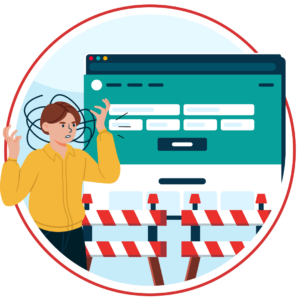
Digital barriers
Digital barriers refer to technological or online barriers that would make it difficult or impossible for disabled employees to do their work. This could be because your intranet system, online application processes, or other online systems are not accessible. It could also include the absence of assistive technology available to disabled employees, such as screen readers.
Organisational barriers
The structure and culture of your organisation also affects its accessibility. Whilst this might conjure up images of hostile workplaces with open prejudice towards disabled people, it also applies to unintentional barriers. You may not intend for your business to discriminate against disabled employees, but rigid, outdated policies and attitudes can also make an impact.
For example, a lack of accessibility policies can disadvantage disabled staff. This makes the company’s stance on inclusivity unclear, so staff may be less likely to voice concerns or be aware of support they can receive.
Absence of accessibility training can also create barriers, as your team may not be aware of how business practices or policies may negatively impact disabled employees.
Get a free automated accessibility check of your websites homepage. This will identify and highlight any compliance issues on your website. Followed by recommendations on how to implement the necessary changes to make your website more accessible.
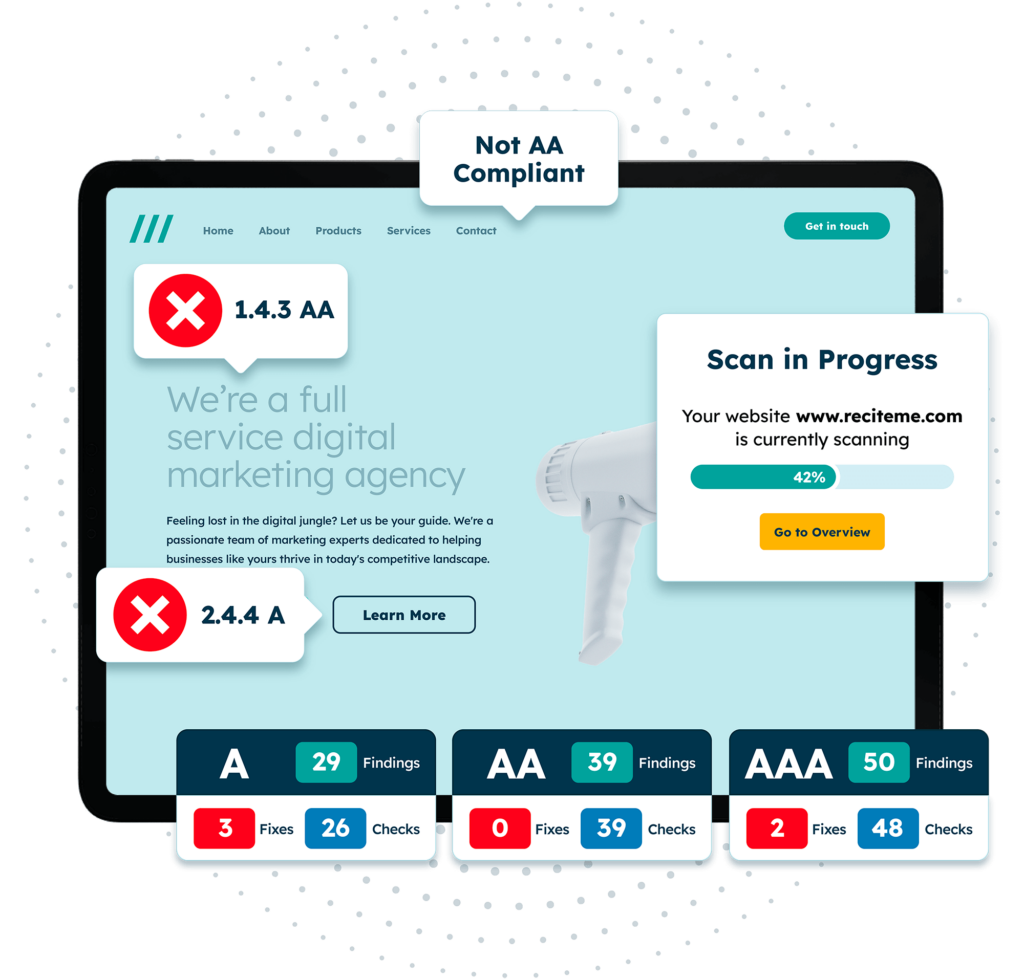
Legal and regulatory framework for accessibility in the workplace
Creating an accessible workplace isn’t just good practice, it’s a legal requirement. Several laws and regulations across the UK and EU set clear expectations for how organisations should support disabled employees. Below is an overview of the most relevant legislation.
The Equality Act
Established in 2010, the Equality Act is intended to defend against discrimination in the UK, including for disabled people. It covers the workplace, where it requires employers to make the workplace accessible, e.g., by providing reasonable adjustments. The Equality Act also requires employers to make any relevant digital aspects accessible to its disabled employees.

If you’re in the public sector, you’ll also need to stay compliant with the Public Sector Bodies Accessibility Regulations 2018. This clarifies that your website, mobile app or intranet need to meet Web Content Accessibility Guidelines (WCAG) 2.2 AA guidelines, and you must also have an accessibility statement on your website.
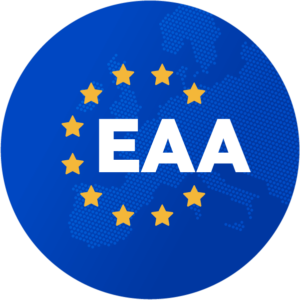
The European Accessibility Act
If you’re in the EU or you sell to the EU, you’ll need to comply with the European Accessibility Act. First enacted in 2019, it requires public and private sector companies to make their digital products and services accessible to disabled people. Keep in mind that it does not apply to companies with under 10 employees and an annual revenue under €2,000,000.
To be compliant, digital content must meet WCAG 2.1 AA guidelines. It’s an important piece of legislation for workplace equality, as you’ll need to ensure any digital services are also accessible to disabled employees.
Designing an accessible workplace
Once you have an understanding of accessibility legislation and guidelines, it’s important to take action. Creating an accessible workplace won’t happen overnight, so your team will need to be proactive. Here are the top factors to consider:
Universal design principles in physical spaces
When evaluating, designing, or developing physical workspaces, aim to use the universal design principles. Architect Ronald Mace first coined the term “universal design” back in 1997. It focuses on creating designs that can be accessed and used by the largest number of people, without further adaptations.

The principles are:
- Equitable Use: The design must be useful to all users, including those with different disabilities.
- Flexibility in Use: This means the design must be adaptable to a variety of ability levels and user preferences.
- Simple and Intuitive Use: The design must not be unnecessarily complicated and must accommodate different skill and experience levels.
- Perceptible Information: The design must be clear and perceivable to the user, regardless of their sensory needs (e.g., visually impaired people must be able to perceive and engage with it, through touch or sound)
- Tolerance for Error: This requires the design to minimise and provide warnings of any hazards or errors
- Low Physical Effort: As it sounds, the design must be used effectively and comfortably at a minimum of physical exertion and fatigue
- Size and Space for Approach and Use: This means the design must provide enough size and space for all users to approach and use it, regardless of body size, type or mobility needs. This includes providing space for assistive devices or personal assistance.
There are lots of ways to apply these principles into the physical environment of your workplace. Wheelchair ramps are a fantastic example, as they allow all users, both disabled and able-bodied, to access buildings.
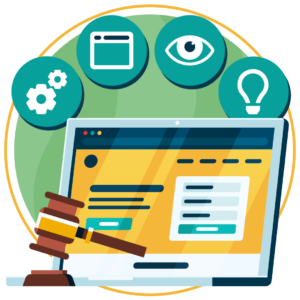
Digital accessibility best practices
Workplace accessibility must also extend to your digital spaces, such as intranet systems, including by:
- Enabling the use of assistive technologies, such as text-to-speech or screen readers
- Meeting WCAG standards, including improving colour contrast, adding alt-text to images, and enabling keyboard-only navigation
- Ensuring media content is accessible by adding synchronised captions and downloadable transcripts
If you’re unsure about how to improve digital inclusivity in your workplace, then it can be helpful to consult with experienced web accessibility consultants. Or to make a start, you could conduct a free web accessibility scan to see where your website stands.
Accessible policies and culture
It’s not enough to just tick off a few physical or digital adjustments. Accessibility in the workplace should run into the fibres of your business, including by:
- Building a strong inclusive work culture, where disabled staff are valued and consulted on accessibility changes, wherever possible
- Taking a firm stand for inclusivity with accessibility statements and policies
- Ensuring all staff are kept informed with accessibility training
- Fostering an open, supportive working environment where staff feel comfortable to speak up about accessibility compliance issues
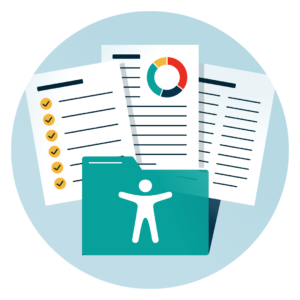
The business case for implementing accessibility
Improving accessibility in the workplace is, at its core, an ethical issue. It’s inherently important to ensure disabled people can have fulfilling careers, equal to their able-bodied peers. But are you also aware of the benefits to your own business?
Inclusivity doesn’t exist in a vacuum. It has a positive impact on other key areas, including:
- Attracting talent: By prioritising accessibility, your business can attract diverse talent, driving innovation and bringing new skills into the company.
- Boosting productivity: Inclusive practices and reasonable adjustments enable disabled employees to excel in their roles, increasing their productivity.
- Employee retention: Data from the Center for Talent Innovation shows that people working in inclusive workplaces are 39% more likely to feel engaged at work. That keeps talented employees loyal to your organization for much longer, reducing turnover.
- Legal compliance: Implementing accessibility across all areas of your business ensures you comply with anti-discrimination laws in your country, such as the Equality Act 2010 in the UK.
- Business reputation: Showing a dedication to accessibility can boost your reputation with customers/clients and the wider public, building trust and increasing your customer base.
- Increased revenue: Accessibility can also make an impact on your bottom-line, as recent data found that, over four years, accessible companies showed revenue increases of 28% on average.
How can Recite Me provide tools for accessible workplaces
As you develop an accessible workplace, you don’t have to go it alone. Recite Me has created several invaluable tools to assist businesses in creating inclusive workspaces, both digitally and physically.
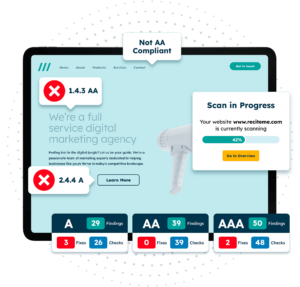
Accessibility Checker
Website accessibility can feel like a minefield. WCAG standards are all-encompassing, but that can also make them daunting to use. Recite Me’s web accessibility checker automatically scans your website and flags up any compliance issues. It covers webpages, but also images, PDFs and other elements.
Once the scan’s complete, it will clarify the steps you’ll need to take to reach compliance. On top of this, the tool can also provide AI fixes for several issues, including alt-text, to save you time.
Accessibility Training
Training ensures that your team understands why they’re implementing an inclusive policy or assistive tech. For example, Recite Me’s free web accessibility courses explain the fundamentals of digital accessibility theory, practice, and legislation.
So, rather than turning online inclusivity into a tick-box exercise, your web developers (and other relevant staff) will understand exactly how their digital design choices shape the web experience of disabled people.

Accessibility Statement & Policy Templates
Accessibility statements and policies are essential for demonstrating your organisation’s commitment to inclusion. They show users, especially those with disabilities, that you recognise their needs and are actively working to meet accessibility standards like WCAG. You can use the following links to download our free templates:
Our 40-page Digital Accessibility & Inclusion Toolkit helps businesses break down online barriers and make a real impact. It offers practical advice on all aspects of digital accessibility, from writing an accessibility statement to accessible website tips and inclusive hiring.
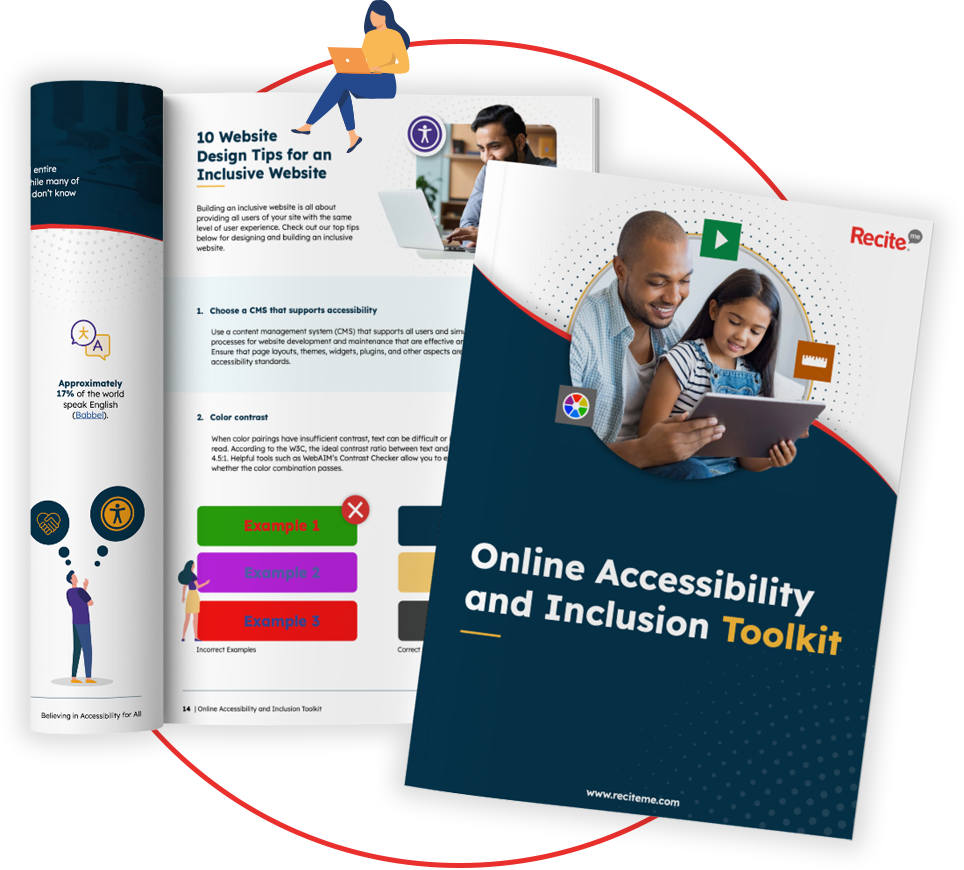
Conclusion: Make sure your workplace is accessibility
Creating an accessible workplace goes far beyond removing physical barriers. From clear accessibility policies to a disability-friendly website, you’ll typically need to make changes across all areas of your organisation. Fortunately, it doesn’t have to be a chore.
Recite Me’s suite of tools can help your company to improve its digital inclusivity, whether you’re in the public or private sector. For your first step, why not start a free website accessibility scan to check your web content for WCAG 2.2 compliance? Or check out our cloud-based assistive toolbar for improved website inclusivity.
Accessibility in the workplace FAQs
Looking for a recap or quick summary? Here are a few of our most frequently asked questions to help you get to grips with the essentials:
How to make workplaces more accessible?
It depends on your organisation, but you should aim to remove any physical, digital or structural barriers in your workplace. That could include:
- Installing wheelchair ramps and automatic doors
- Developing accessible parking spaces
- Creating an accessible website
- Establishing a clear accessibility policy
Why is accessibility important in the workplace?
On the most fundamental level, accessibility promotes inclusivity and enables disabled people to live fulfilling work lives. There are also benefits for your business, including improved employee productivity and loyalty, meeting legal compliance, and the opportunity to attract talented disabled staff.
What are the legal requirements for workplace accessibility?
This will depend on your business location and service-type. Important legislation includes the Equality Act 2010 in the UK and the Americans with Disabilities Act (ADA) in the US.
However, the main legal requirement is providing reasonable adjustments to prevent disabled staff from being disadvantaged at work.
What are the main rules of accessibility?
Accessibility guidelines and legislation typically require employers to provide reasonable adjustments for disabled staff. Businesses need to remove accessibility barriers, whether physical, digital or systemic. Digitally, the best rubric to follow is the Web Content Accessibility Guidelines (WCAG), which states that accessible content should be Perceivable, Operable, Understandable and Robust.
Do offices have to be accessible?
Yes, accessibility legislation, such as the UK Equality Act 2010, Americans with Disabilities Act, and the Accessible Canada Act, applies to offices. You’ll need to ensure your office is physically accessible, such as by installing accessible bathrooms, and by fostering a flexible, disability-inclusive environment.

